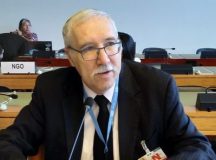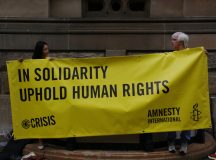The systematic omission of Hamas’ massive underground terror infrastructure from the 2024 Human Rights Watch Gaza report, part of a twenty-year pattern of obfuscation, is only one sign of a deeper problem with the NGO superpower. ‘The removal of the artificial “halo” that has protected this NGO and its leaders from scrutiny and accountability for their central role in weaponising human rights for hate propaganda is now long overdue’ argues Gerald Steinberg.
Introduction
Nine months after the 7 October atrocities, Human Rights Watch (HRW) has published what the NGO’s leaders, PR team and allies hailed as a ‘landmark’ report detailing Hamas brutality and Israeli victims. This 245-page document consists of text, photos, and forensic analysis – including images of watches on the arms of victims that displayed the exact moment of their decapitation, rape, kidnapping and murder by the Palestinian terrorists. In addition to the documentation, most of which reiterated information known for many months, HRW included pages of solemn recommendations to the leaders of Hamas, the Palestinian Authority, the United Nations, and Israel.
However, in contrast to the hype in the press releases, social media posts and headlines praising HRW, described as ‘a harsh critic of Israel,’ for also documenting the war crimes of 7 October, a closer examination demonstrates that the publication is another in the organisation’s long history of human rights hypocrisy. Far from the comprehensive research methodology claimed by HRW, the study adds to the organisation’s previous transparent exercises in highly selective and distorted reporting. The details of the attacks that were included were already well-known and systematically ignored while HRW issued nine reports and hundreds of statements couched in the language of international law that whitewashed Hamas and its allies, vilified Israel and contributed directly to virulent antisemitism.
Where have the tunnels gone?
One core dimension of the conflict is entirely and conspicuously absent from the report – the hundreds of kilometers of concrete terror tunnels constructed deep underground. In the past twenty years, concealed entrances were built into buildings, hospitals, UNRWA schools, UNICEF clinics, mosques, sports fields and everywhere else. But for the numerous authors of this ‘comprehensive’ report, they do not exist.
The command centers of Hamas and its various terror allies (Islamic Jihad, etc.) are located in this massive interconnected underground highway and terror complex, constructed from stolen humanitarian aid. Without the expendable Palestinian human shields above ground in Gaza to protect this terror complex, and the belief that Yahya Sinwar, Mohammed Deif and other Hamas commanders were safe from counterstrikes, they could not have triggered the war against Israel. The tunnels that, in some cases, extended under the border into Israel to facilitate attacks and kidnappings, were also used to hide many of the Israelis who survived the brutality and were kidnapped on 7 October, as well as the bodies of the mutilated victims.
The tunnels were far from a secret – for years, everyone in Gaza, including hundreds of UN officials, humanitarian aid workers and doctors with Médecins Sans Frontières, journalists and activists who came to express solidarity, including from HRW, knew of their existence and importance. After 7 October, many open-source independently verifiable platforms with numerous videos have documented the Gaza underground infrastructure, estimated to include 500 kilometers. The New York Times featured a lengthy and detailed analysis, headlined ‘How Hamas Is Fighting in Gaza: Tunnels, Traps and Ambushes‘ (13 July 2024). In contrast, HRW’s top researchers, analysts and experts conspicuously excised all mention of this central part of the Hamas war crimes strategy and preparations.
This is not merely a small detail – it is a fundamental omission. Indeed, in this loud silence, as well as in many other respects, HRW’s July 2024 ‘comprehensive’ report is a charade and continuation of the obfuscations and distortions that have characterised the organisation’s numerous publications, statements, social media posts and advocacy campaigns related to Israel. As documented below, in the past 20 years, HRW devoted hundreds of pages to assisting Hamas in protecting the tunnels, at first by belittling their extent and significance, and then by ignoring and erasing them, while condemning every Israeli move to uncover and destroy the underground terror infrastructure.
On this, as on many other aspects of the conflict, as well as in labeling Israel as illegitimate via the ‘apartheid’ campaign, HRW plays a key role in shaping the narrative in UN bodies (particularly the UN Human Rights Council, where the NGO has a network of former employees, staffers, and allies), media platforms and academic frameworks that focus on international law and human rights. With an annual budget of approximately $100 million and a large public relations and media staff, HRW’s Gaza narrative and accusations against Israel are highlighted and amplified in these venues. This cynical effort has been successful and reflected in the catastrophic results of death and destruction, not only on 7 October, but long before, and is likely to continue.
HRW’s 2004 ‘Razing Rafah’ report, ‘disproportionate attacks’ and minor smuggling tunnels
HRW’s first round in protecting Gaza’s underground terror highway was a 2004 report headlined Razing Rafah: Mass Home Demolitions in the Gaza Strip, and accompanied by a well-orchestrated marketing campaign, including a media blitz and press conference in Jerusalem, held by Executive Director Kenneth Roth, HRW’s Israel-obsessed leader until 2022. The clear purpose of that 135-page document (HRW are experts in creating the illusion of research by filling pages with irrelevant details and verbiage) was to create political pressure on Israel to stop the military operation aimed at uncovering and destroying the tunnels and the entrances below houses built along the border between Gaza and Egypt. Citing ‘independent experts on clandestine tunnels,’ HRW declared with great authority that ‘the IDF has consistently exaggerated and mischaracterised the threat from smuggling tunnels to justify the demolition of homes,’ which the NGO officials then cite in accusations of ‘collective punishment’, war crimes and ‘violations of international law.’ The ‘smuggling’ casually dismissed by Roth included terrorists and explosives used by Palestinian suicide bombers, directed by Arafat and Hamas, in which over 1,000 Israelis were murdered and thousands more were injured.
Quotes from HRW’s press release and Roth’s interviews were published in numerous mainstream media platforms, and the 2004 report’s allegations were repeated, without any verification, in UN documents and by diplomats and academics. HRW also exploited the accidental death of Rachel Corrie, an ardent student activist who was sent by the radical International Solidarity Movement to Rafah to stand in front of IDF bulldozers.
In the months and years that followed, HRW repeated the claims of the 2004 report. In one of many examples, the boycott campaign targeting the Caterpillar Corporation, which manufactures the D9 bulldozers used to uncover the tunnel entrances, demanded an end to sales to Israel: ‘The Israel Defense Force (IDF) claims the destruction is required to block smuggling tunnels and for force protection. Based on extensive research in Gaza, however, Human Rights Watch determined that the IDF has destroyed many homes regardless of whether they posed a military threat…’
2005-2009: Gaza Terror Tunnels Expand, the Goldstone Report Farce and HRW
The ‘smuggling tunnels’ that HRW and its ‘independent experts on clandestine tunnels’ blithely dismissed expanded quickly after the Israeli withdrawal from Gaza in August 2005, followed two years later by the Hamas coup and expulsion of the Palestinian Authority. The concrete infrastructure deep underground provided protection for producing and storing thousands of deadly rockets with constantly increasing range, for rapid launch at Israelis. In 2006, tunnels dug below the border into Israel were used by Hamas to kill a number of soldiers and capture Gilad Shalit, who was held until the 2011 exchange in which over 1000 Palestinian terrorists were released from Israeli jails. In 2008, Hamas greatly escalated the number of rocket attacks and demonstrated the capacity to strike over longer ranges, causing serious injury including to children, and forcing thousands of civilians to run to shelters.
These events triggered an IDF ground and air operation in Gaza (Cast Lead) that began at the end of December 2008, with the objective of destroying the underground terror infrastructure. HRW again led the intense campaign of accusations of Israeli war crimes, repeated by journalists and political leaders, creating immense pressure and causing the government led by Ehud Olmert to agree to a ceasefire after three weeks, and without achieving the objectives. In parallel, the heavily biased UN Human Rights Council (UNHRC) created an entirely one-sided Commission of Inquiry, led by Richard Goldstone, who was also a member of HRW’s advisory board.
HRW issued five lengthy reports with demonising headlines like ‘Killings of Palestinian Civilians during Operation Cast Lead’ alleging Israeli war crimes, as well as numerous press statements and social media posts, without mentioning the ‘smuggling tunnels’ in Gaza. Roth and HRW accused Israel of collective punishment, disproportionate and indiscriminate use of force, ‘unlawful attacks causing civilian casualties,’ and an ‘unlawful blockade’ of Gaza that ‘caused severe shortages of food, water, electricity, and medicines.’ An HRW statement in the UNHRC accused Israel of creating a ‘dire humanitarian situation in Gaza’ that ‘has reached catastrophic proportions…’ again, with no mention of terror tunnels and their central role in the Hamas war strategy.
Following the lead of HRW as well as Amnesty International and other NGOs claiming human rights agendas, Goldstone’s report, which copied hundreds of unverified NGO and media accusations, all but ignored the tunnels, and when they were mentioned, these were again dismissed as minor nuisances, used for ‘the entry of otherwise unavailable goods.’ In contrast, the text repeated the HRW and NGO litany of accusations charging the IDF with ‘violation of international humanitarian law,’ citing Palestinian testimony (also unverified) of having been questioned by Israeli security forces, ‘under threat of death or injury to extract information about Hamas, Palestinian combatants and tunnels.’ Notwithstanding the blatant emphasis on striking the tunnels in Israel’s defense of its citizens, the UN sham commission headed by Goldstone, like HRW, had no interest in investigating the underground terror network in Gaza. Later, Goldstone acknowledged that he had been misled and regretted his role, but the damage was done.
2010-2024: HRW ‘sees no tunnels, hears no tunnels, speaks no tunnels’
An examination of HRW’s numerous publications, posts, interviews and related activity in the years that followed demonstrate a clearly deliberate policy of denying the existence of the Hamas underground terror highway and command centers. Between 2010 and 2021, HRW’s numerous statements on Gaza condemned Israel’s blockade as a form of ‘collective punishment’, and violation of international law, while erasing the continuous buildup of the aggressive capabilities by Hamas and its allies, protected by the massive underground infrastructure.
Only one of HRW’s annual report chapters on Israel-Palestine in this period referred to the tunnels. That exception, which centered on the 2014 war (Protective Edge), contained an acknowledgement that ‘Palestinian armed groups’ had built a network of ‘tunnels they used to launch attacks in Israel.’ The chapter then highlighted an agreement that ended this round, which included ‘a monitoring mechanism for imports of the materials.’ The mechanism, like many others, quickly disappeared, and work on expanding Gaza’s underground terror complex accelerated.[1]
In HRW’s numerous accusations of Israeli war crimes during and after the 2021 fighting (Guardian of the Walls), the references to the Gaza tunnels, which, by this time, had expanded even further, were very minor and couched in language that called for skepticism. For example, one major report claimed that, following the collapse of three buildings after nearby missile strikes, the ‘Israeli military said that they targeted tunnels … [and] an underground command center,’ cynically adding ‘without providing any details or evidence.’ The same language was repeated regarding a number of other reported strikes, followed by the declaration that ‘Human Rights Watch did not find any evidence of a military target at or near the site of the airstrikes, including tunnels or an underground command center…’ In contrast, HRW cited without question the ‘evidence’ from anonymous and entirely unverifiable Palestinian ‘eyewitness testimony.’
Given this history, this conspicuous omission in HRW’s otherwise very detailed report on the 7 October atrocities is entirely consistent. Under Ken Roth’s leadership (which formally ended in 2022, but continues to be reflected in the agenda adhered to by his hand-picked staff), the NGO had created and repeated a twenty-year fiction of minor ‘smuggling tunnels’ that, according to this narrative, Israel cynically exaggerated in order to justify war crimes in Gaza. How could HRW turn around now and acknowledge the existence of an underground terror complex of hundreds of kilometers, constructed under hospitals, schools, residences, mosques and sports fields, using massive amounts of stolen aid, in order to protect the leadership and combatants of Hamas and allied terror organisations, as well as their weapons arsenals, including an estimated 30,000 rockets – all actual war crimes?
Such an honest assessment, if it had occurred, would mean that Israel’s counter-terror operations in Gaza were and are legitimate, beginning in 2004 and continuing 9 months after the 7 October 2024 atrocities. It would also mean that throughout this period, HRW had actively assisted Hamas in creating soft-power pressure, including lawfare, to prevent Israel from acting to prevent the attacks and preparations for a massacre that culminated on 7 October.
The Weaponisation of Human Rights
The systematic erasure of Gaza’s underground terror infrastructure was not the only fundamental failure in HRW’s report purporting. The lengthy background section repeats many of the myths and distortions that, like the tunnels, are part of the standard weaponisation of human rights and international law for the objective of demonising Israel, as practiced since Ken Roth became Executive Director of HRW in 1993. Some of the allegations are factually false, such as the accusation of ‘using starvation as a method of warfare,’ and HRW simply copies the clearly refuted casualty claims of the Hamas-controlled Gaza Health Ministry.
Additionally, Salo Aizenberg notes that despite the claims made by HRW as providing original material, the central 13-page section on sexual violence ‘only regurgitates’ many existing reports – including detailed Israeli reporting and the Screams Before Silence documentary. Nevertheless, the authors assert that none of this evidence can be ‘independently corroborated,’ and declared that HRW ‘did not document any cases of rape but, owing to the methodological and ethical challenges set forth below, does not take this to mean that they did not occur.’ In comparison, HRW has published hundreds of pages in reports filled with accusations against Israel based on entirely unverifiable ‘eyewitness testimony’ and journalists’ reports, which do not include such caveats.
In the realm of international law, which is inherently open to sleights of hand, and in which HRW also specialise, the publication falsely asserts that ‘Despite having no troops permanently stationed in Gaza since 2005, Israel has remained the occupying power under international humanitarian law.’ Similarly, they repeat the slogan that ‘Israel’s prolonged closure of the Gaza Strip constitutes a form of collective punishment and is part of the crimes against humanity of apartheid and persecution that Israeli authorities are committing against Palestinians.’ Recommendations directed at Israel (‘provide the ICC, UN Commission of Inquiry, UN Office of the High Commissioner for Human Rights… and independent [sic] human rights organizations’ which are leading demonisation campaigns against Israel ‘with immediate cooperation and unhindered access to all of Israel and the Occupied Palestinian Territory’) are clearly designed for propaganda purposes, further reducing the credibility of the report.
Furthermore, HRW’s publication on the 7 October atrocities came nine months after the events, while, as noted above, in the same time period the organisation produced and vigorously marketed nine reports and a continuous stream of press statements, interviews and social media posts that condemned the Israeli responses in Gaza, repeating the allegations of war crimes, collective punishment, genocide and starvation.
These aspects support the conclusion that this report is a one-off token, as part of HRW’s charade of ‘balance’ and ‘neutrality’ for donors, journalists, and others, to offset the reality of blatant bias and anti-Israel campaigning. This is another standard practice for HRW. For example, in 2002, Roth and HRW were severely criticised by the organisation’s donors and founder Robert Bernstein for studiously ignoring two years of Palestinian mass bombings that killed over 1000 Israelis and wounded many more, while issuing numerous condemnations of the Israeli counterterror effort. A few months later, they published a solitary report ‘documenting’ the attacks, but HRW erased the publicly available evidence showing Arafat’s role in directing the attacks and devoted significant space to condemning Israel. Immediately after this flawed report was published, it was forgotten. No essays were published in major media platforms, no submissions were made to UN agencies, and no interviews followed. HRW has repeated this strategy of tokenism, double standards, and hypocrisy periodically since then. In 2009, Bernstein, who no longer had an active role in the organisation, condemned HRW’s central role in making Israel ‘a pariah state’ in an article published in the New York Times and a number of public lectures.)
The systematic bias and weaponisation that permeates HRW was recently confirmed by Danielle Haas, a senior editor at HRW for 13 years, who provided examples of the ‘years of politicization’ in singling out Israel. The organisation’s conduct, she noted, violates ‘basic editorial standards related to rigor, balance, and collegiality’ and the ‘principles of accuracy and fairness.’ HRW’s response to the 7 October Hamas massacre invoked ‘the ‘context’ of ‘apartheid’ and ‘occupation’ before blood was even dry on bedroom walls.’ Recalling HRW’s 2021 publication labeling Israel as an ‘apartheid’ state, Haas observed that HRW staff knew that this, like all of the organisation’s lengthy reports ‘would rarely be read in full,’ and the unverified accusations would be widely cited as incontrovertible evidence. The same applies to the current report.
Removing HRW’s Protective Halo
In the nine months after the 7 October Hamas atrocities, Human Rights Watch has produced a continuous stream of demonising accusations and condemnations of the Israeli response, while, with very few and largely invisible comments, erasing the Israeli victims. The organisation was among the first to invoke the accusations of war crimes and violations of law in referring to the Israeli response in Gaza, accompanied by intensive media campaigns whitewashing Hamas and supportive of the sham ‘genocide’ case brought by South Africa in the International Court of Justice and the starvation allegations from the prosecutor of the International Criminal Court.
Given this background, and as detailed in this analysis, it is clear that the objective of the July 2024 ‘landmark’ publication the accompanying marketing campaign was to whitewash the systematic weaponising of the moral principles articulated in the 1948 Universal Declaration of Human Rights, adopted in the shadow of the Holocaust.
The blatant and systematic omission of Gaza’s massive underground terror infrastructure in the report and in the preceding 20 years, as well as the other basic flaws, highlight this NGO superpower’s ongoing bias and core political objectives. These began with HRW’s central role in the infamous antisemitic 2001 UN Durban conference ostensibly on the elimination of racism, in which the NGO Forum adopted a plan of action with the explicit objective of ‘the complete international isolation of Israel’ following the strategy of boycotts and lawfare used against the South African apartheid regime. For the next 23 years, HRW systemically weaponised human rights and the facade of international law to attack and delegitimise Israel.
Throughout this period and continuing to this day, HRW continues to be described as ‘a highly respected’ source of information and as a promoter of moral principles, in contrast to the evidence. The removal of the artificial ‘halo’ that has protected this NGO and its leaders from scrutiny and accountability for their central role in weaponising human rights for hate propaganda is long overdue.
[1] On the systematic political censorship and manipulation in the chapters on Israel and Palestine in HRW’s annual reports, see Danielle Haas ‘The Human-Rights Establishment Human rights are too important to be left to human-rights groups,’ Sapir, Volume 12, 2024 https://sapirjournal.org/friends-and-foes/2024/03/the-human-rights-establishment/?




































